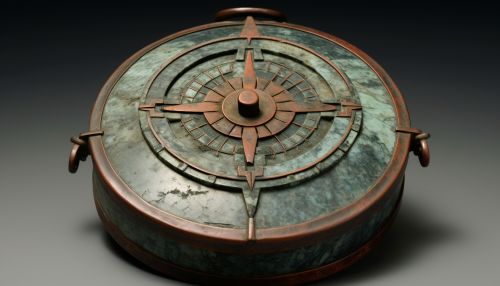Compass
History
The compass is an instrument used for navigation and orientation that shows direction relative to the geographic cardinal directions. The word compass comes from the Latin 'com-' meaning "together" and 'passus' meaning "a step or pace". The invention of the compass significantly improved maritime navigation during the Age of Discovery.
The first compasses were made of lodestone, a naturally magnetized ore of iron, in ancient China around the 2nd century BC. These early compasses were used for astrology and feng shui, rather than navigation. The compass was later used for navigation during the Song Dynasty of the 11th century. Later compasses were made of iron needles, magnetized by striking them with a lodestone.


Design and Construction
A compass functions as a pointer to "magnetic north" because the magnetized needle at its heart aligns itself with the horizontal component of the Earth's magnetic field. The magnetic field exerts a torque on the needle, pulling one end or pole of the needle approximately toward the Earth's North magnetic pole, and the other toward the South magnetic pole.
The compass needle is balanced on a low-friction pivot point, in better compasses a jewel bearing, so it can turn easily. When the compass is held level, the needle turns until, after a few seconds to allow oscillations to die out, it settles into its equilibrium orientation.
The magnetic compass is the most familiar compass type. It functions as a pointer to "magnetic north", the local magnetic meridian, because the magnetized needle at its heart aligns itself with the two horizontal components of the Earth's magnetic field, the inclination and the intensity.
A compass is any magnetically sensitive device capable of indicating the direction of the magnetic north of a planet's magnetosphere. The face of the compass generally highlights the cardinal points of north, south, east and west.
Types of Compasses
There are many types of compasses including magnetic compasses, gyrocompasses, and GPS compasses. Each type has its own specific uses and advantages.
Magnetic Compass
The magnetic compass contains a magnet that interacts with the earth's magnetic field and aligns itself to point to the magnetic poles. Its design may be as simple as a magnetized needle that can rotate on a pivot, or may include damping features such as fluid to smooth the needle's motion, or mechanisms to reduce or eliminate the effects of pitch and roll in an aircraft or ship.
Gyrocompass
A gyrocompass is a type of non-magnetic compass which is based on a fast-spinning disc and rotation of the Earth (or another planetary body if used elsewhere in the universe) to automatically find geographical direction.
GPS Compass
A GPS compass or GPS navigation device uses signals from GPS satellites to determine the device's location and direction. Unlike magnetic and gyrocompasses, a GPS compass is not affected by magnetic anomalies or by the movement of the vessel or vehicle it is installed on.
Applications
Compasses have a wide range of applications in different fields. They are used in navigation, surveying, mapping, and other activities where direction is important.
In navigation, a compass is an essential tool. Mariners and pilots have relied on them for centuries. They are used to find the direction of the magnetic North Pole, which is essential for accurate navigation.
Surveying
In surveying, compasses are used to measure the relative direction of survey lines. This information is used to create detailed maps and plans.
Military
In the military, compasses are used in land navigation courses and are part of basic training. They are also used in conjunction with maps and other tools in mission planning and execution.
